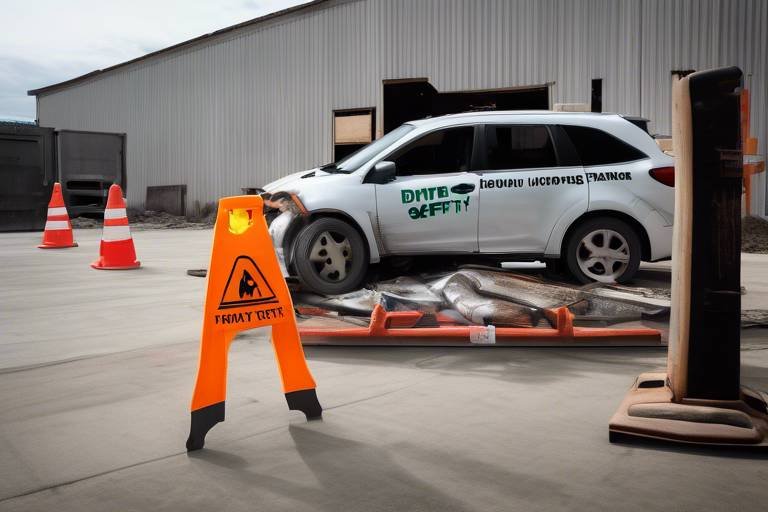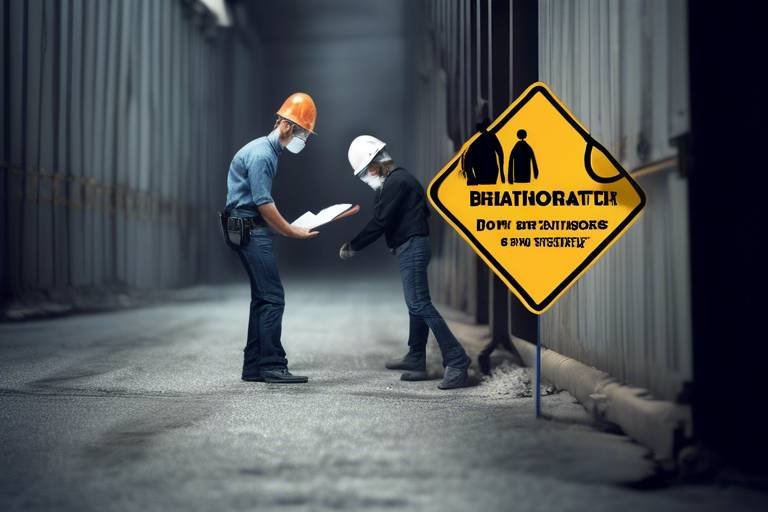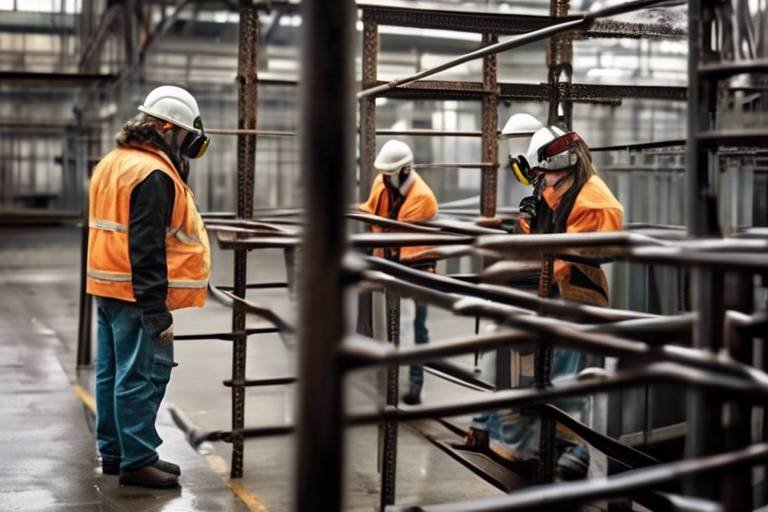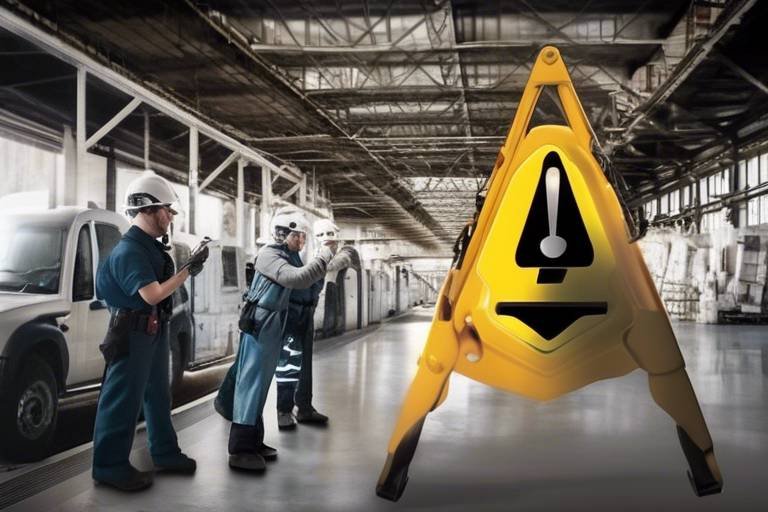Can Safety Measures be Uplifted through Understanding Human Behavior?
In today's world, safety is more than just a set of rules and regulations; it's a complex interplay of human behavior, psychology, and social dynamics. Have you ever wondered why some people seem to ignore safety protocols while others adhere to them religiously? The answer lies in understanding the intricate relationship between human behavior and safety measures. By diving deep into psychological insights and social influences, we can not only enhance safety protocols but also significantly reduce risks across various environments.
Imagine walking into a construction site. You see hard hats, safety vests, and warning signs everywhere. Yet, despite these visible safety measures, accidents can still happen. Why? It often boils down to how individuals perceive risk and their subsequent behaviors. This article will explore how understanding these nuances can lead to more effective safety measures in our daily lives.
One of the most fascinating aspects of human behavior is how our cognitive biases and emotional factors shape our perception of risk. For instance, when faced with a potential hazard, some individuals may underestimate the danger due to overconfidence, while others might be paralyzed by fear. This variation in risk perception can lead to inconsistent adherence to safety protocols. By recognizing these psychological patterns, safety professionals can tailor their approaches to better resonate with individuals' mindsets.
Moreover, social dynamics play a pivotal role in influencing safety behavior. Have you ever noticed how people tend to follow the crowd? This phenomenon, known as peer pressure, can significantly impact individual choices regarding safety practices. For example, if a group of friends decides to forgo wearing seatbelts during a road trip, an individual may feel compelled to join in, despite knowing the risks. Understanding these social influences can help in crafting strategies that promote positive safety behaviors within communities.
As we delve further into the realm of safety, we must also consider the cultural attitudes towards safety. Different cultures have varying perceptions of risk and safety, which can greatly influence how safety measures are implemented and adhered to. For instance, in some cultures, there may be a strong emphasis on individual responsibility, while in others, collective responsibility is prioritized. Recognizing these cultural differences is essential for effective policy-making and the development of safety measures that resonate with diverse populations.
In our globalized world, comparing safety practices across countries can provide invaluable insights. Different nations adopt varied approaches based on their unique cultural norms. For instance, countries with stringent safety regulations often experience lower accident rates. By studying these global practices, we can learn valuable lessons and adapt successful strategies to enhance safety measures in our own communities.
Encouraging positive safety norms is another critical aspect of improving safety measures. By fostering a culture of safety through community engagement and education, we can create environments where individuals feel empowered to prioritize safety. For example, community workshops that focus on safety training and awareness can significantly enhance compliance and reduce risks. When individuals understand the importance of safety, they are more likely to adopt positive behaviors.
Group dynamics also play a significant role in safety compliance. The behavior of a group can heavily influence individual adherence to safety protocols. Strong leadership is vital in promoting compliance and establishing a culture of safety within organizations. Leaders who model safe behaviors and actively engage their teams in safety discussions can create a ripple effect, encouraging others to follow suit.
Effective communication strategies are essential for conveying safety measures. Clear and concise communication can enhance understanding and compliance among individuals. Utilizing various communication channels, such as meetings, emails, and visual aids, can ensure that safety messages are effectively delivered and understood. Moreover, involving stakeholders in safety initiatives fosters collaboration and leads to better outcomes.
In conclusion, understanding human behavior is key to uplifting safety measures. By recognizing the psychological, social, and cultural factors that influence risk perception and safety behavior, we can develop more effective safety protocols. As we move forward, let’s embrace the power of human behavior to create safer environments for everyone.
- How does understanding human behavior improve safety measures?
Understanding human behavior helps identify cognitive biases and social influences that affect risk perception, allowing for tailored safety protocols. - What role does culture play in safety practices?
Cultural attitudes towards risk and safety can significantly impact how safety measures are perceived and implemented. - Why is communication important in safety compliance?
Effective communication ensures that safety messages are clearly understood, enhancing compliance and reducing risks. - How can communities promote positive safety norms?
Through engagement and education, communities can foster a culture of safety that encourages individuals to prioritize safe behaviors.

The Psychology of Risk Perception
Understanding how individuals perceive risk is a fundamental aspect of shaping effective safety measures. It’s fascinating to realize that our perception of risk is not solely based on objective statistics; rather, it’s heavily influenced by cognitive biases and emotional factors. For instance, have you ever noticed how people often overestimate the likelihood of rare events, like plane crashes, while underestimating more common risks, such as car accidents? This discrepancy can be attributed to the availability heuristic, where people judge the frequency of an event based on how easily examples come to mind. Such biases can lead to poor decision-making, especially in safety-related contexts.
Moreover, emotions play a pivotal role in how we assess risk. When faced with potential danger, our emotional responses can cloud our judgment. For example, the fear of an unknown hazard can amplify our perception of risk, leading us to either take excessive precautions or, conversely, to dismiss the danger entirely due to a sense of invulnerability. This phenomenon is especially prevalent in high-stakes environments, such as construction sites or healthcare settings, where the stakes are high, and the potential consequences of misjudgment can be severe.
It’s also essential to recognize that risk perception is not a solitary experience; it’s often shaped by social influences. People tend to look to others when making judgments about safety. If a group of friends decides to engage in a risky behavior, such as not wearing helmets while biking, individuals within that group may feel pressured to conform, despite their personal beliefs about safety. This social conformity can lead to a collective underestimation of risk, which is why understanding group dynamics is crucial for enhancing safety protocols.
To illustrate the complexity of risk perception, consider the following table that summarizes key factors influencing how individuals perceive risk:
| Factor | Description |
|---|---|
| Cognitive Biases | Judgments influenced by psychological shortcuts, such as the availability heuristic. |
| Emotional Responses | Feelings that can either heighten or diminish perceived risk based on personal experiences. |
| Social Influences | Peer pressure and group norms that affect individual risk assessments. |
| Cultural Context | How cultural backgrounds shape attitudes toward risk and safety. |
In conclusion, to enhance safety measures effectively, it’s imperative to delve into the psychology of risk perception. By understanding the cognitive and emotional factors at play, as well as the social dynamics that influence individual behavior, we can craft safety protocols that resonate more deeply with people. This understanding not only helps in mitigating risks but also empowers individuals to make informed decisions regarding their safety. So, the next time you think about safety measures, remember that it’s not just about rules and regulations; it’s about understanding the human psyche.
- What is risk perception? Risk perception refers to the subjective judgment people make about the characteristics and severity of a risk.
- How do cognitive biases affect risk perception? Cognitive biases can lead individuals to misjudge the likelihood of risks, often causing them to either overestimate or underestimate dangers.
- Why is emotional response important in risk assessment? Emotions can significantly influence how risks are perceived and can lead to irrational decision-making in safety contexts.
- How can social influences change safety behavior? Social dynamics, such as peer pressure, can lead individuals to conform to group behaviors that may not align with their personal safety beliefs.

When we talk about safety, it's easy to think of rules and regulations as the main players in the game. However, the truth is that social influences can significantly shape our behavior when it comes to safety practices. Have you ever noticed how your friends' actions can sway your own decisions? This phenomenon isn’t just about peer pressure; it’s a complex interplay of social dynamics that can either promote or hinder safety compliance.
One of the most compelling aspects of social influence is the role of peer pressure. Imagine you’re at a construction site where everyone is wearing helmets and safety gear. If you choose not to wear a helmet, you might feel the weight of your colleagues' gazes, subtly nudging you to conform. This is where the group norm kicks in. When safety becomes a collective value, individuals are more likely to adopt those behaviors themselves. It’s like a domino effect—one person wears their gear, and soon, everyone follows suit.
Social dynamics also extend beyond peer interactions. Cultural factors play a significant role in shaping safety behaviors. For instance, in some cultures, there is a strong emphasis on community and collective responsibility, which can lead to heightened safety awareness. Conversely, in more individualistic cultures, people may prioritize personal freedom over safety precautions. This cultural backdrop can deeply influence how safety measures are perceived and enacted.
Furthermore, the impact of leadership in promoting safety cannot be overstated. Leaders set the tone for safety culture within organizations. When leaders prioritize safety, it sends a powerful message to employees that their well-being is valued. It’s akin to a captain steering a ship; if the captain is vigilant about navigating through storms, the crew is likely to follow suit. Conversely, if leaders neglect safety protocols, it can create a culture where safety is seen as optional rather than essential.
To further illustrate these dynamics, let’s look at a table that compares the influence of various social factors on safety behavior:
| Social Factor | Influence on Safety Behavior |
|---|---|
| Peer Pressure | Encourages compliance through social conformity. |
| Group Norms | Establishes collective expectations for safety practices. |
| Cultural Attitudes | Affects how safety is prioritized within a community. |
| Leadership | Shapes organizational safety culture and employee behavior. |
In summary, understanding the social influences on safety behavior is crucial for developing effective safety measures. By recognizing how peer pressure, group norms, cultural attitudes, and leadership impact individual choices, we can create environments that promote safety as a shared value. So next time you think about safety, remember that it’s not just about rules—it’s about the people around us and the social fabric that binds us.
- How does peer pressure affect safety behavior? Peer pressure can either encourage individuals to follow safety protocols or lead them to ignore them, depending on the group’s norms.
- What role does culture play in safety practices? Cultural attitudes towards risk and safety can greatly influence how individuals perceive and adhere to safety measures.
- How can leaders promote a culture of safety? Leaders can promote safety by prioritizing it in their policies and demonstrating commitment through their actions.

Cultural attitudes towards safety are like the invisible threads that weave through the fabric of society, influencing how we perceive risk and respond to safety measures. In some cultures, safety is viewed as a communal responsibility, while in others, it may be seen as an individual concern. This divergence can significantly impact how safety protocols are developed and adhered to. For instance, in collectivist societies, there is often a stronger emphasis on group safety, where individuals prioritize the well-being of the community over personal risk. This can lead to a more proactive approach to safety, as people feel a shared obligation to protect one another.
On the flip side, in more individualistic cultures, safety may be regarded as a personal matter, leading to varied compliance with safety measures. Here, the focus might be on personal freedom and choice, which can sometimes overshadow the importance of collective safety practices. This difference in perspective can create challenges when implementing safety protocols across diverse cultural landscapes. For example, a safety campaign that works well in one country may fall flat in another due to cultural misunderstandings or differing values regarding risk and responsibility.
Moreover, cultural attitudes towards safety are often shaped by historical experiences and societal norms. Countries that have faced significant safety crises, such as natural disasters or industrial accidents, may develop a heightened awareness of safety protocols. In contrast, cultures with fewer such experiences might not prioritize safety as heavily, potentially leading to complacency. These historical contexts can be crucial in understanding why certain safety measures are embraced or resisted in different regions.
To effectively address these cultural differences, policymakers and safety organizations must adopt a tailored approach. This means engaging with communities to understand their unique attitudes towards safety and risk. By fostering open dialogues and involving community members in the decision-making process, organizations can create safety measures that resonate with local values and beliefs. For example, in some cultures, storytelling and community discussions can be powerful tools for promoting safety awareness, as they align with traditional methods of knowledge sharing.
In conclusion, recognizing and respecting cultural attitudes towards safety is essential for developing effective safety measures. By understanding these cultural nuances, we can create more inclusive and effective safety protocols that not only protect individuals but also resonate with the community's values. This approach not only enhances compliance but also fosters a culture of safety that is sustainable in the long run.
- How do cultural attitudes affect safety practices?
Cultural attitudes shape how communities perceive risk and responsibility, influencing compliance with safety measures and the development of protocols. - What role does communication play in promoting safety in different cultures?
Effective communication tailored to cultural contexts can enhance understanding and compliance with safety measures, fostering a culture of safety. - Can technology help bridge cultural gaps in safety awareness?
Yes, technology can be leveraged to share safety information across cultural boundaries, making it accessible and relatable to diverse audiences.

When we look at safety practices across the globe, it's like peering into a fascinating kaleidoscope of cultural perspectives and operational methodologies. Each country has its own unique approach to safety, shaped by historical events, societal norms, and economic conditions. For instance, in countries like Japan, safety is ingrained in the culture, stemming from the lessons learned from natural disasters like earthquakes. Here, the concept of “kaizen”, or continuous improvement, permeates safety protocols, ensuring that safety measures are not only implemented but also constantly refined.
On the other hand, in some Western countries, safety regulations may be more focused on compliance rather than cultural integration. The approach can often be more legalistic, where organizations comply with safety laws to avoid penalties rather than fostering a genuine culture of safety. This difference in perspective can lead to varied outcomes in safety effectiveness. To illustrate these disparities, the following table summarizes key safety practices in different regions:
| Region | Safety Approach | Key Focus Areas |
|---|---|---|
| Japan | Cultural Integration | Continuous Improvement, Community Engagement |
| United States | Regulatory Compliance | Legal Standards, Penalty Avoidance |
| Germany | Systematic Safety Management | Engineering Controls, Worker Training |
| India | Emerging Safety Culture | Awareness Campaigns, Policy Development |
In addition to these differences, we can also observe that some regions emphasize community involvement in safety practices more than others. For example, Scandinavian countries often prioritize a collective approach to safety, where community input is not just welcomed but actively sought. This can lead to a more robust safety culture, as individuals feel a sense of ownership and responsibility towards the safety measures in place.
As we compare these global practices, it's essential to recognize that no single approach is universally applicable. What works in one context may not be effective in another. Therefore, understanding these differences is crucial for policymakers and safety professionals who aim to enhance safety measures in their own regions. By learning from the successes and challenges faced by different cultures, we can develop a more nuanced and effective approach to safety that takes into account the diverse human behaviors that influence safety compliance.
- What are some common safety practices worldwide? Safety practices can vary widely, but common elements include risk assessments, employee training, and emergency preparedness plans.
- How can cultural differences impact safety measures? Cultural attitudes towards authority, risk, and community can significantly influence how safety measures are perceived and implemented.
- Why is community involvement important in safety practices? Community involvement fosters a sense of ownership and responsibility, which can lead to better adherence to safety measures and improved overall safety outcomes.

Creating a culture that prioritizes safety is not just about enforcing rules; it's about fostering an environment where individuals feel empowered to take responsibility for their own safety and the safety of others. Imagine a workplace where everyone actively participates in safety discussions, sharing ideas and concerns without fear of judgment. This kind of atmosphere can significantly enhance compliance with safety protocols. But how do we get there? It starts with education and engagement.
One effective way to encourage positive safety norms is through community engagement initiatives. When individuals are involved in safety programs, they are more likely to take ownership of their actions. Consider organizing workshops or safety drills that not only inform but also involve participants in hands-on activities. This interactive approach can transform safety from a mundane obligation into an exciting challenge. For instance, you could host a competition where teams create safety awareness campaigns, allowing creativity to flourish while reinforcing the importance of safety.
Moreover, communication plays a pivotal role in shaping safety norms. It’s essential to use clear and relatable language when discussing safety measures. Instead of jargon-heavy terms that can confuse or alienate people, opt for straightforward explanations that resonate with everyone. Utilizing stories and real-life examples can make safety protocols more relatable. For instance, sharing a story about how a small safety measure prevented a serious accident can have a profound impact on how individuals perceive safety practices.
Another strategy is to leverage peer influence. People are often more motivated to comply with safety norms when they see their peers doing the same. This is where leadership comes into play. Leaders should model positive safety behaviors and encourage their teams to do the same. By recognizing and rewarding safe practices, organizations can transform safety compliance into a shared goal. Imagine a scenario where employees are celebrated for their contributions to safety; this not only boosts morale but also reinforces the idea that safety is everyone's responsibility.
Furthermore, integrating safety into the fabric of organizational culture can yield significant benefits. This can be achieved by making safety an integral part of the performance review process. When safety is recognized as a key performance indicator, employees are more likely to prioritize it. Additionally, having regular safety meetings where team members can discuss safety concerns and share suggestions can create a continuous feedback loop, ensuring that safety remains a top priority.
Lastly, technology can be a powerful ally in promoting positive safety norms. Utilizing apps and online platforms to share safety tips, document incidents, and track compliance can enhance awareness and accountability. For example, a mobile app that sends out daily safety reminders or alerts can keep safety at the forefront of everyone's mind. By embracing technology, organizations can create a more informed and safety-conscious community.
In conclusion, encouraging positive safety norms is a multifaceted endeavor that involves education, communication, leadership, and technology. By fostering an environment where safety is valued and prioritized, we can significantly reduce risks and enhance overall safety practices. Remember, safety is not just about rules; it's about creating a culture where everyone feels responsible and empowered to contribute.
- What are positive safety norms? Positive safety norms are shared beliefs and practices within a community or organization that prioritize safety and encourage individuals to take proactive measures to protect themselves and others.
- How can technology help in promoting safety? Technology can provide tools for communication, training, and monitoring safety practices, making it easier to disseminate information and encourage compliance.
- Why is community engagement important for safety? Community engagement fosters ownership and accountability among individuals, making them more likely to adhere to safety measures and participate actively in safety initiatives.
- How can leaders influence safety behavior? Leaders can model positive safety behaviors, recognize and reward compliance, and create an open environment for discussing safety concerns, thereby influencing their teams to prioritize safety.

When it comes to safety compliance, the power of group dynamics cannot be overstated. Imagine a workplace where everyone is on board with safety protocols; it creates an environment where individuals feel empowered to adhere to regulations. On the flip side, if even one person disregards safety measures, it can lead to a ripple effect, causing others to question the importance of compliance. This phenomenon is often referred to as the bandwagon effect, where individuals align their behaviors with those of the group, consciously or subconsciously.
In many cases, group norms dictate what is considered acceptable behavior. For instance, if a team regularly skips safety checks, new members may feel pressured to conform, believing that this behavior is the norm. This can lead to a dangerous culture where safety is compromised. To combat this, it's essential to foster an environment where positive safety behaviors are not just encouraged but celebrated. By highlighting and rewarding compliance, organizations can shift the group dynamic towards a more safety-conscious culture.
Leadership plays a crucial role in shaping these group dynamics. When leaders prioritize safety and demonstrate their commitment through actions and policies, it sets a tone that resonates throughout the organization. They can utilize various strategies to influence group behavior, such as:
- Modeling Behavior: Leaders who adhere to safety measures themselves set a powerful example.
- Open Communication: Encouraging team members to voice concerns about safety fosters a culture of transparency.
- Team Training: Regular training sessions can reinforce the importance of safety and create a shared understanding among team members.
Moreover, creating small groups or teams that focus on specific safety initiatives can enhance compliance. When individuals feel accountable to their peers, they are more likely to follow through on safety protocols. This accountability can be further strengthened through regular check-ins and discussions about safety practices during team meetings.
In conclusion, understanding group dynamics is essential for improving safety compliance. By recognizing the influence of social interactions and leadership on behavior, organizations can implement strategies that promote a culture of safety. The ultimate goal is to create an environment where safety is not just a set of rules but a shared value that everyone actively participates in upholding.
Q1: How do group dynamics affect safety compliance?
A1: Group dynamics significantly influence safety compliance as individuals often conform to the behaviors and norms of their peers. If safety practices are prioritized within a group, members are more likely to adhere to them.
Q2: What role does leadership play in promoting safety?
A2: Leadership is crucial in establishing a culture of safety. Leaders who model safe behaviors, communicate openly about safety, and engage their teams in safety initiatives can positively influence compliance.
Q3: Can technology aid in enhancing safety compliance?
A3: Absolutely! Technology can facilitate communication, provide real-time safety updates, and create platforms for reporting safety concerns, ultimately enhancing compliance.

When it comes to safety measures, effective communication is the backbone of any successful initiative. Imagine trying to build a house without a solid foundation; it simply won’t stand. In the same way, safety protocols need clear and consistent communication to be understood and followed by everyone involved. But what does effective communication look like in the context of safety? It’s not just about handing out flyers or sending out emails; it’s about engaging individuals on a personal level and making the information relatable and actionable.
One of the key aspects of effective communication is understanding your audience. Different groups may have varying levels of comprehension regarding safety protocols, and it’s crucial to tailor your message accordingly. For instance, using technical jargon might confuse employees on a factory floor, while a more straightforward approach would resonate better. On the flip side, technical staff may require more in-depth information to fully grasp the safety measures at play. This is where the art of communication comes into play—adapting your message to fit the audience's needs.
Moreover, utilizing multiple channels for communication can significantly enhance understanding. Relying solely on one method, such as verbal announcements, can lead to information being misinterpreted or forgotten. Instead, consider a multi-channel approach that includes:
- Visual Aids: Infographics, charts, and videos can simplify complex information and make it more digestible.
- Workshops and Training Sessions: Interactive sessions allow individuals to ask questions and engage with the material actively.
- Regular Updates: Consistency is key. Frequent reminders and updates keep safety measures at the forefront of everyone’s mind.
Another vital element of effective communication is the feedback loop. It’s not enough to simply disseminate information; organizations must also encourage feedback from employees. This two-way communication fosters a sense of involvement and ownership over safety practices. For example, consider implementing regular safety meetings where team members can voice their concerns or suggest improvements. This not only enhances safety protocols but also builds trust within the organization.
Additionally, leveraging technology can significantly boost safety communications. In today’s digital age, utilizing apps and online platforms can disseminate information quickly and effectively. For instance, mobile applications can send real-time alerts about safety hazards or updates on protocols. Social media can also be a powerful tool for raising awareness and engaging the community in safety initiatives. Imagine a scenario where a company shares a safety tip of the week on their social media channels, encouraging employees and followers to share their own experiences or tips. This creates a community around safety, making it a shared responsibility.
Finally, it’s essential to measure the effectiveness of your communication strategies. Are people understanding the safety protocols? Are they adhering to them? Collecting data through surveys or assessments can provide valuable insights into what’s working and what needs improvement. This continuous cycle of feedback and adaptation ensures that safety communication remains relevant and effective.
Q1: Why is effective communication crucial for safety measures?
A1: Effective communication ensures that everyone understands the safety protocols, leading to better compliance and reduced risks.
Q2: How can technology enhance safety communication?
A2: Technology can provide real-time updates, facilitate training, and engage individuals through interactive platforms and applications.
Q3: What role does feedback play in safety communication?
A3: Feedback creates a two-way communication channel, allowing individuals to express concerns and suggest improvements, fostering a culture of safety.

In today's fast-paced world, technology is not just a luxury; it's a necessity, especially when it comes to enhancing safety awareness. Think about it: we carry powerful computers in our pockets, and the potential for these devices to save lives is enormous. From mobile apps to social media platforms, technology offers innovative ways to communicate safety measures and engage individuals in a meaningful way.
For instance, imagine a scenario where a community is alerted about a natural disaster through a dedicated mobile app. This app can send real-time notifications, provide safety tips, and even offer evacuation routes. By leveraging technology, we can ensure that crucial information reaches people quickly, making them more prepared and less anxious. It's like having a safety net that stretches across the community, ready to catch anyone who might fall into danger.
Moreover, social media platforms have become powerful tools for spreading awareness. They allow organizations to share safety protocols and updates instantly. For example, during a public health crisis, health departments can use platforms like Twitter and Facebook to inform the public about safety guidelines, vaccination drives, and preventive measures. This rapid dissemination of information helps reduce panic and misinformation, fostering a more informed community.
Another exciting avenue is the use of virtual reality (VR) and augmented reality (AR) in safety training. Imagine firefighters undergoing training in a VR environment that simulates real-life scenarios. This immersive experience not only enhances learning but also prepares them for actual emergencies. By incorporating technology into training programs, we can significantly improve the effectiveness of safety education.
To further illustrate how technology can enhance safety awareness, consider the following table that highlights various technological tools and their applications:
| Technology | Application | Benefits |
|---|---|---|
| Mobile Apps | Real-time alerts and safety tips | Immediate access to critical information |
| Social Media | Information dissemination and community engagement | Wider reach and faster communication |
| VR/AR | Training simulations for emergency responders | Enhanced preparedness and skill development |
| Wearable Devices | Health monitoring and alerts | Proactive identification of health risks |
In addition, wearable technology such as smartwatches can monitor health metrics and alert users to potential health issues. For instance, if a user’s heart rate spikes unexpectedly, the device can send an alert, prompting them to seek medical attention. This proactive approach can be a game-changer in personal safety, allowing individuals to take charge of their well-being.
However, while technology offers numerous benefits, it's essential to remember that it should complement, not replace, traditional safety measures. Educating the public about how to use these technologies effectively is crucial. After all, even the best technology is useless if people don’t know how to use it or trust it. Therefore, ongoing training and awareness campaigns are vital to ensure that technology enhances safety awareness rather than complicates it.
In conclusion, utilizing technology for safety awareness is not just a trend; it's a fundamental shift in how we approach safety. By embracing these tools, we can create a more informed and prepared society. So, the next time you reach for your smartphone, remember that it holds the potential to be a powerful ally in keeping you and your community safe.
- How can I ensure I receive safety alerts on my mobile device? Most safety apps allow you to customize notifications. Make sure to enable them in your device settings.
- Are there specific apps recommended for emergency preparedness? Yes, apps like FEMA, Red Cross, and local emergency management apps are excellent resources.
- How can social media improve safety awareness? Social media can quickly disseminate information, provide updates during emergencies, and foster community engagement around safety practices.
- What role does VR training play in safety? VR training immerses individuals in realistic scenarios, enhancing their readiness and response skills in actual emergencies.

Engaging stakeholders in safety initiatives is not just a best practice; it's a necessity for creating a robust safety culture. When we talk about stakeholders, we refer to anyone who has an interest in safety outcomes—employees, management, local communities, and even regulatory bodies. Each of these groups brings unique perspectives and insights that can significantly enhance safety protocols. So, how do we effectively engage these stakeholders? It starts with open communication and collaboration.
First and foremost, it’s essential to create a platform for dialogue. Regular meetings, workshops, and forums can serve as excellent venues for stakeholders to voice their concerns and suggestions. This not only fosters a sense of ownership but also encourages collective responsibility towards safety. Imagine a workplace where every employee feels empowered to speak up about potential hazards—this is the kind of environment that can drastically reduce risks.
Additionally, integrating feedback loops into safety initiatives can prove invaluable. For instance, after implementing a new safety measure, gathering input from stakeholders on its effectiveness can lead to continuous improvement. This iterative process ensures that safety protocols remain relevant and effective. To illustrate, consider a scenario where a manufacturing plant introduces new machinery. By involving operators in the evaluation of safety features, the management can uncover practical insights that might have otherwise gone unnoticed.
Moreover, leveraging technology can enhance stakeholder engagement. Digital platforms can facilitate real-time communication and feedback, making it easier for everyone involved to stay informed and involved. For example, using mobile apps to report safety concerns can empower employees to take immediate action without the fear of repercussions. This technological integration not only streamlines communication but also reinforces the idea that safety is a shared responsibility.
Lastly, recognizing and rewarding stakeholder contributions can further motivate engagement. When individuals see that their input leads to tangible changes, they are more likely to participate actively in future initiatives. This could be as simple as acknowledging their efforts in company meetings or creating a rewards program for innovative safety suggestions. By fostering a culture of recognition, organizations can build a more committed and proactive safety community.
In summary, engaging stakeholders in safety initiatives is about creating an inclusive environment where everyone feels valued and heard. By fostering open communication, integrating feedback, leveraging technology, and recognizing contributions, organizations can cultivate a culture of safety that not only meets regulatory standards but exceeds them.
- Why is stakeholder engagement important in safety initiatives?
Engaging stakeholders ensures diverse perspectives are considered, leading to more effective and comprehensive safety measures. - How can technology aid in stakeholder engagement?
Technology can facilitate real-time communication, feedback collection, and streamline reporting processes, making it easier for stakeholders to participate. - What are some effective ways to recognize stakeholder contributions?
Recognition can be achieved through public acknowledgment, rewards programs, or incorporating their suggestions into safety policies.
Frequently Asked Questions
- How does understanding human behavior improve safety measures?
Understanding human behavior allows us to tailor safety measures that resonate with individuals' perceptions and emotions. By recognizing cognitive biases and emotional responses, we can design protocols that are more intuitive and effective, ultimately reducing risks in various environments.
- What role does risk perception play in safety compliance?
Risk perception is crucial because it influences how individuals assess danger and decide on safety practices. When people underestimate risks due to cognitive biases, they may neglect safety protocols. By addressing these biases, we can enhance compliance and promote safer behaviors.
- How do social influences affect safety behaviors?
Social dynamics, such as peer pressure and cultural norms, significantly impact individual choices regarding safety. When safety is prioritized within a group, individuals are more likely to adopt similar behaviors, creating a culture of safety that benefits everyone.
- What are some cultural attitudes towards safety?
Cultural attitudes towards safety vary widely across different societies. Some cultures may prioritize risk-taking, while others emphasize caution. Understanding these differences is vital for developing effective safety policies that resonate with diverse populations.
- How can we encourage positive safety norms in communities?
Promoting positive safety norms can be achieved through community engagement and education. Initiatives like workshops, safety drills, and awareness campaigns can foster a collective commitment to safety, encouraging individuals to prioritize safe practices in their daily lives.
- What is the importance of effective communication in safety measures?
Effective communication is essential for ensuring that safety measures are understood and followed. Clear messaging, using relatable language and appropriate channels, helps individuals grasp the importance of safety protocols and motivates them to comply.
- How can technology enhance safety awareness?
Technology plays a pivotal role in enhancing safety awareness by providing platforms for information sharing. Apps, social media, and online resources can disseminate safety tips and updates quickly, reaching a broader audience and facilitating timely responses to safety concerns.
- Why is stakeholder engagement important in safety initiatives?
Engaging stakeholders, including organizations, communities, and individuals, is crucial for the success of safety initiatives. Collaboration fosters a sense of ownership and accountability, leading to more effective safety measures and better outcomes for all involved.



















